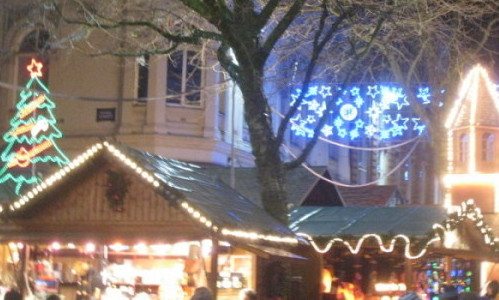Christmas is all around me
Paris, France – Selina Sykes
There is something even more magical about the City of Lights during the festive season. For me, Parisian Christmas charm goes beyond the sparkling lights along Les Champs Elysées and the glittering fir tree towering in Galeries Lafayettes.
As a keen gourmand, what I look forward to the most is the markets. After all, Christmas is a time for enjoying good food! Oozing with atmosphere and crammed with stalls selling traditional produce and handmade crafts, Christmas markets bring European cities to life come December.
Dating back to the 1400s, the tradition of Christmas markets originates from Germany and the Alsace region in France. From food specialities to crafts, artisans would travel from afar to trade their goods. Since then the tradition has spread to cities throughout Europe.
The most famous and largest Marché de Noël in France is located in Strasbourg. While nowhere does Christmas markets better than Germany, the French capital does provide a rather wonderful winter spectacle just at the other end of the Eurostar.
There are several markets dotted around Paris, the largest stretching along Les Champs Elysées. Starting in late November, clusters of quaint wooden chalets line the streets, bustling with shoppers in search of presents for loved ones. The air may be cold and crisp, but you’ll be warmed up by mulled spiced wine, roasted chestnuts and hot crêpes.
Whether you’re in need of a scenic winter stroll, traditional foodstuffs or handcrafted gifts, Christmas markets are the perfect place for your festive preparations. The Parisian markets worth visiting are those at Les Champs-Elysées, Saint-German-des-Près, Trocadero, La Défense, Montparnasse, Saint Suplice and Les Halles.
Luxembourg – Helena Skinner
An ideal destination for a Christmas break is the charming city of Luxembourg. The capital of the equally unfamiliar country of Luxembourg has the elegance of a cosmopolitan city, yet is steeped in chocolate box charm.
Luxembourg is a quintessentially European city; its architecture is shaped by its French and German influences, yet it remains staunchly independent. The country’s motto is ‘We want to remain what we are’.
As a Grand Duchy, Luxembourg has a passion for monarchy that rivals Britain. What better way to celebrate Christmas than with the Grand Duchy’s annual commemorative Christmas plate?
If you are looking for kitschy Christmas souvenirs, the city’s idyllic old quarter is a network of narrow cobbled streets perfect for an afternoon spent window-shopping.
An essential visit must also be made to Place d’Armes where the traditional Christmas market takes place, wooden huts sell candles, tankards, and other festive goods, it is worth sampling the sausages, potato pancakes and mulled wine.
Nestled on high cliffs the city has some great vantage points, be sure to check out Place de la Constitution, the sight of mist gathering in the valley below is a treat on a winter’s afternoon.
Perhaps the jewel in Luxembourg’s Grand Duchy is the fantastical ‘Chocolate House’ opposite the Palais Grand. A huge array of delectable tiered cakes and a multitude of different hot chocolates are on offer, served as chocolate molds on the end of a stick, they make great stocking fillers.
Luxembourg is a great destination for a brief weekend stop, if only for the twee festive food eateries.
Oban, Scotland – Robin James Kerrison
There’s nowhere quite like Scotland. It’s the largest portion of the UK that is not yet overrun with metropolitan areas. It has its heritage, its customs, its own language – though I’m yet to meet anyone who speaks Gaelic – and enough natural beauty to quench any thirst for awe-inspiring landscapes.
With that in mind, my main Christmas present last year was a trip to the coastal town of Oban, and my brother and I are spending a few days over Christmas there again.
The town sits on a near-perfect horseshoe bay – hence its name: Oban is derived from the Gaelic for “bay.” The town looks out across the water to the Isle of Kerrera, beyond which lies the Isle of Mull.
The Sound of Kerrera’s connection to and relative protection from the Atlantic make it a haven for seafood, as I discovered with my first taste of mussels in one of many well-established restaurants that the town’s status as a tourist destination has necessitated.
Scotland has more in her arsenal of aesthetically pleasing landscapes than just her west coastline and, within fifty miles inland of Oban, she gifts us mountains galore. Not only are the stumpy former volcanoes a treat to see looming on the horizon, but they provide a natural challenge that the rest of the UK just cannot.
Even an Alp doesn’t give me quite the quick of a Munro: even Mont Salève, which overlooks Geneva and offers some quite incredible views of Geneva’s eponymous lake, didn’t give me the same sense of achievement as Ben Challum or Ben Narnain did. One of the mountains near Oban, Cruachan, is even hollowed out like something from Lord of the Rings and houses a power station.
I also have a soft spot for Scotland given that it produces my most favourite beverage: single malt whisky. There’s a service station that claims to be world famous in Tyndrum, a little while north of Loch Lomond on the A82, known as The Green Welly Stop. It does a remarkably good bacon butty, but its main appeal for me is its huge selection of single malts, where you can even try before you buy. Note that a single sip of whisky will fight off a whole day of highland winter.
All in all, whether you want mussels, whiskey or breathtaking views that cannot be rivalled south of the border, Scotland’s west coast is where to be this Christmas.
Istanbul – Yasemin Ulusoy
With the colourful street lights signalling the approach of the holiday season, a friend of mine asked me if I think it’s sad that we don’t have Christmas trees. She had a point, so I did some research and found out that this tradition can be traced back further than one of the biggest events in the Christian year.
Although the modern Christian trees originated in eighteenth century Germany, worshipping trees as a symbol of eternal life can be traced back to ancient Egyptians and Babylonians.
In many countries and religions, Christmas trees were believed to keep away evil spirits and illnesses. The Egyptians believed the winter solstice marked the recovery of Ra (The Sun God) from his illness, and they decorated their homes with green plants to symbolize the triumph of life over death. The Early Romans celebrated Saturnalia in honour of Saturn (God of Agriculture), and the evergreen decorations celebrated the approach of spring and fertility.
A paradox I had every holiday season as a child in Turkey was having a ‘Christmas tree’ in our house even though, like most other families, we didn’t celebrate Christmas. I have come to understand that we all share these customs for different reasons.
Rather than being another trap of capitalism, the tree is a symbol of celebration – whether your focus is on religion, coming together with family and friends, or reflecting on the year gone by. The practices can be accepted as an old tradition our ancestors left us, or just an excuse to decorate dull grey cities.
London, UK – Aneesa Patel
There’s only one place to begin: Christmas lights! There is a host of big names to switch on the lights in different areas of London, so I’d definitely recommend going to see them switched on at places like Oxford Street, Carnaby Street or Westfield Stratford City.
Amid the excitement comes the Christmas tree, and there is none like the one in Trafalgar Square. The significance of this tree is its tradition; it has been provided as a gift from Oslo to London every year since 1947.
London’s cityscape is a beauty in its natural state, but to witness that dim view of a rustic city transform into such an enlightened image is truly unforgettable.
The best way to view this enhanced beauty is with a long, peaceful night-time walk around the city and along the main bridges, especially Tower Bridge.
There are already an unbelievable amount of things to do in London, but everyone steps it up a notch at Christmas. My personal favourite is Hyde Park’s Winter Wonderland. On entering the markets, you are immediately hit with the smell of cinnamon and baked goods – the sweet smell of Christmas!
Not to mention Santa Land, The Magical Ice Kingdom, amazing eateries, and the UK’s largest outdoor ice rink, illuminated with more than 100,000 lights. Other exciting events include The Enchanted Woodland at Syon Park and Hogwarts in the Snow.
Over Christmas, Londoners themselves experience a big change – visitors go from being surrounded by grumpy city folk to enjoying the kind, helpful company of those around them. This communal spirit is one so rare that it should definitely be experienced.
Finally, when Christmas has drawn to a close, the Boxing Day Sales arrive! With two Westfield shopping centres, Oxford Street, Knightsbridge and much more, London is a great place to snatch up seasonal bargains.
To top it all off, New Year’s celebrations follow, and from the famous yearly fireworks over the Thames to the innumerable New Year’s parties, London is the place to be.
… or a Christmas spent at home – Stephanie Hartley
Chicken, turkey, goose: an alternative choice? What we eat and how we celebrate Christmas is integral to our family traditions. Even down to the timings of the day, we all have our own routines.
This is why most people remain at home over the holidays. There is a fear in many, especially those of the older generation, that Christmas will not be “the same”; a phrase which gets thrown around endlessly over the holiday period.
Another phrase that comes to mind is the idea that ‘home is where the heart is’. People wish to remain with their families during this time: it is a time for relaxation and bonding – something which rarely occurs on a family holiday.
Although travelling is usually deemed a time for relaxation, travelling over the Christmas period does induce stress, as not only are you not in the comfort of one’s own home, but the food will never be adequate to everyone’s desires and the routine will have been disturbed.
In many families, mothers and grandmothers are at the heart of Christmas planning and that well-established routine. Everybody adheres to their own traditions for their own well-being, but also for their mothers’. This is their time to shine, and a time to appreciate them for what they have done over the year.
To conclude, I return to the statement already outlined, that home is where the heart is; why would you need to travel elsewhere to find the roots of Christmas celebration; family, love and happiness?


Comments